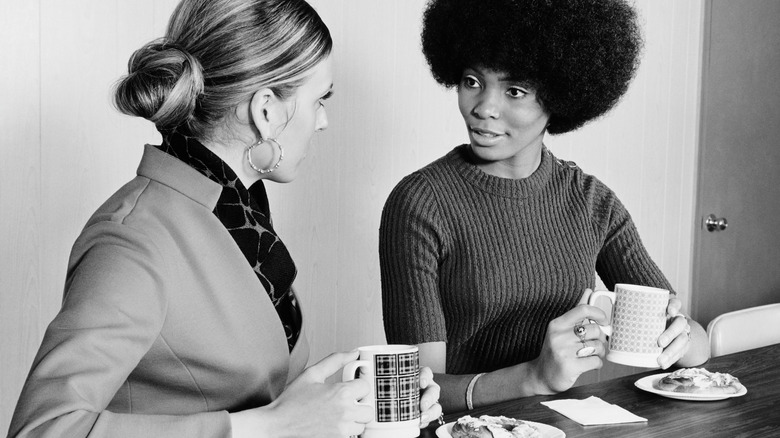The Bill Paying Etiquette Of Second-Wave Feminism
Deciding who will pay the bill on a dinner date can sometimes lead to awkward silences or a wrestling match over the check. Before the women's liberation movement of the 1960s and 1970s — also known as second-wave feminism — widely accepted etiquette rules in the U.S. suggested that men should "take care" of women: hail their cabs, offer to take their coats, pull out their chairs, order their meals, and yes, pay for their dinners. Even in a business lunch scenario, it was considered uncouth for a woman to pay at all, even if she organized the outing, held a position of higher seniority, and was using her company's account. However, these norms underwent adjustments as more women strove for equality.
The 1969 edition of Emily Post's book "Etiquette" sought solutions to avoid embarrassing men when women offered to foot the bill. Post recommended that women use a credit card instead of cash, as it was more discreet. Fumbling around with dollar bills at the table should definitely be avoided. For women without credit cards — a significant number, since a woman's individual access to credit cards was not legally protected until 1974 — the polite approach was to discuss her intention to pay with her male dinner guest upfront and give him the money ahead of time. This would help him avoid the awkwardness of being seen with a woman paying for his meal.
Second-wave feminism was multifaceted progress
Second-wave feminism, inspired by the civil rights movement and anti-war activists, called for women's equality across all arenas — politics, the workplace, the home, interpersonal relationships, and social settings. Similarly, first-wave feminism, which focused on the legal standing of women — particularly the right to vote — also piggybacked off the momentum of the abolitionist movement. In both cases, as upper-class white women joined the fight, the voices of Black women and women of color were often overlooked or intentionally excluded. Women of color faced both sexism and racism, and sought to highlight the intersectionality of these struggles.
Second-wave feminism presented various, sometimes contradictory, perspectives. Some believed it was important for women to demonstrate that they could step into any role held by a man, while others viewed this as erasing some unique strengths of women. The nuanced middle ground depicted in Emily Post's book seemed to toe this line, suggesting that even if a woman could pay for a meal, perhaps it was better for her to preserve the peace.
What is the modern etiquette on who pays the bill?
Some people still feel most comfortable with the assumption that the man should foot the bill — and the gratuity — as a matter of customs and manners; for others, it is a well-deserved gesture, since women still do not receive equal pay, have the same legal rights, or walk through the world as safely as men. For others, the notion of the man always footing the bill feels antiquated. This tradition also fails to provide clarity for same-gender and non-binary couples.
The most consistent rule of thumb seems to be that the person who extends the invite pays, regardless of gender. Some couples like to alternate who picks up the tab, while others decide to split the bill going forward. Many couples make a decision that feels equitable based on each person's income. While much of Emily Post's etiquette advice on this topic falls into the category of archaic restaurant etiquette rules that should be rewritten, one piece still holds true — the suggestion to have a conversation. After a couple of dates, having a discussion to get on the same page is a good next move. When it comes to money matters, it's always better to seek clarity rather than make assumptions that can cause resentment and hurt feelings.



